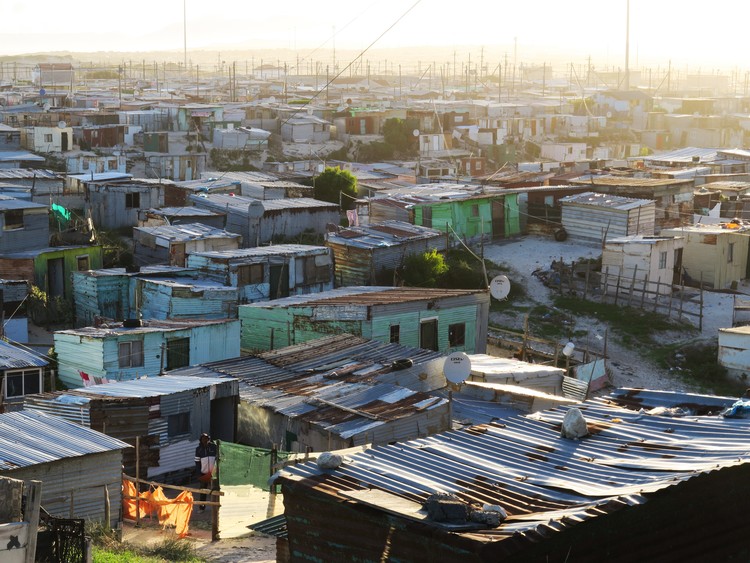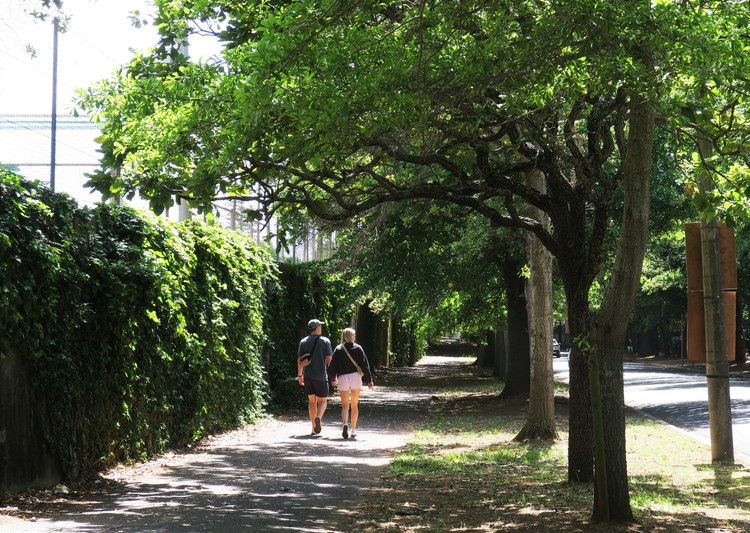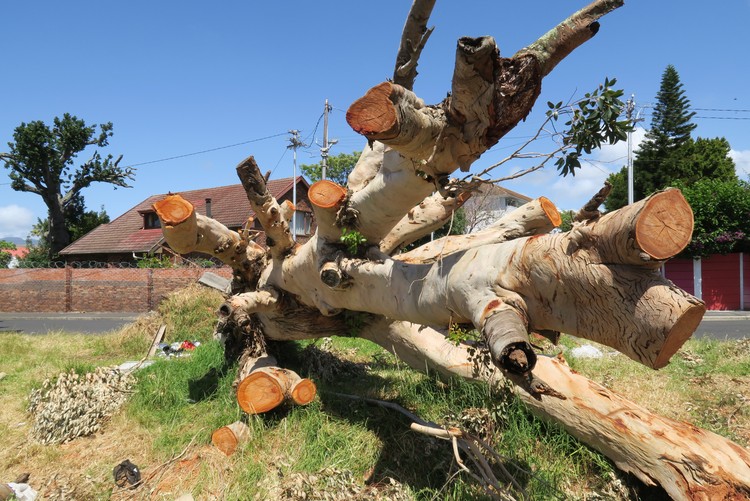Cape Town is losing its trees
As global temperature records continue to be broken, cities need to move fast to protect residents from heat stress. Planting trees seems the simplest solution
In some parts of the city there are no trees at all. Photo: Steve Kretzmann
- As global temperatures heat up, residents of cities are especially vulnerable.
- Scientists say planting trees is a simple way to protect people in cities from heat stress.
- But Cape Town may be losing trees faster than they are being replaced.
- Trees are being felled to reduce shade on solar panels, and are dying from beetle infestations and storm damage.
Cape Town may be losing trees faster than they are being replaced, making the city more vulnerable to the effects of global warming.
The loss of trees and the shade they provide has a direct impact on the Urban Heat Island effect, with air and surface temperatures much higher in urban than in rural environments.
As global temperatures rise due to the burning of fossil fuels and loss of forests at the rate of almost 5-million hectares a year, cities are particularly vulnerable, as building materials and city surfaces trap and reflect heat. This can pose a threat to health and life; the August 2003 European heatwave is believed to have led to more than 70,000 additional deaths.
With more than half of South Africa’s population living in urban areas, and global temperatures moving inexorably upward, the Council for Scientific and Industrial Research (CSIR) states Urban Heat Islands “will increasingly affect the livelihood of residents as the urban population grows”.
Senior researcher in African Futures and Innovation at the Institute for Security Studies, Alize le Roux, has stated that rapidly rising temperatures due to the climate crisis are turning South Africa’s growing urban “areas into “a ticking time bomb”.
“Those most at risk are the poor, elderly and young, people living in informal dwellings without proper insulation and ventilation, those reliant on public transport, and communities without access to green spaces and water,” stated le Roux in a 2021 article.
A heat mapping study by Heat Watch Cape Town found air temperature differences of up to 16.3°C across the city on 28 February. The hottest areas, where temperatures were between 38.1° and 41.6°, were in the city centre along Strand Street, and in Woodstock, as well as in Maitland and Paarden Eiland. The well-treed Newlands and Rondebosch areas were cooler at around 31°, with Rocklands in Mitchell’s Plain, which is close to the ocean, being the coolest mapped area on the day at below 26°. Although Rocklands has few trees, the researchers note the amount of open space such as the adjacent Philippi horticultural area, along with an ocean breeze, can reduce the temperature in that area.
Numerous studies have found that trees are a cost-effective means of reducing heat. Trees also reduce pollution and flooding caused by rapid storm water runoff.
Trees are a cost-effective way of reducing heat. Photo: Steve Kretzmann
3-30-300
To reduce the Urban Heat Island effect, and promote nature-based solutions for sustainable, resilient, and healthy urban areas, the United Nations Economic Commission for Europe developed a policy brief which calls for cities to implement a target of at least 30% tree cover.
The UN said beyond the cooling effect, trees also improved mental well-being and social relations. To this end, the UN proposed the “3-30-300” rule in which every person should be able to see at least three mature trees from their home or place of work, each neighbourhood should have at least 30% tree canopy cover, and the maximum distance to the nearest “high-quality green public space” should be 300 metres.
But Cape Town, which experiences hot and dry summers, only has about a 6% tree canopy, according to City community and health mayco member Patricia van der Ross. The target, said van der Ross, is 10%.
But we are losing trees faster than we are replacing them, says arborist Francois Krige who runs a tree felling business and spearheads the reforestation of Platbos. In a recent webinar on tree cover and biodiversity loss in the Cape, Krige said the infestation of Polyphagous Shot Hole Borer beetle in the southern suburbs had led to the loss of about 6,000 trees. Heavy rainfall and strong winds this winter had led to the further loss of about 2,000 trees which were uprooted, he said.
Just shy of 2,150 trees were planted by the City during the 2023/24 financial year, according to van der Ross, a rapid decline from the recent high of about 3,380 planted in the 2021/22 financial year. Planted trees only had about a 70% success rate, said van der Ross. This means the number of trees planted in 2023/24 which are expected to survive, is about 1,500.
“That will do little to decelerate the rate of tree cover loss,” said Krige. He said the increasing use of solar panels as a result of Eskom loadshedding had also led to extensive tree loss on private property as home owners did not want shade across their roofs.
“Solar panels have had a devastating impact on trees,” he said, with hundreds of trees in the city having been cut down or severely lopped to ensure full sun on solar panels. He said rather than eliminating all shade, homeowners should add an extra solar panel or two to generate the amount of electricity they needed.
Heavy winter storms led to the loss of thousands of trees, such as this eucalyptus in Diep River. Photo: Steve Kretzmann
Aliens to the rescue
Asked what plan is in place to plant trees in areas such as Khayelitsha, Mitchells Plain, and Dunoon, where there is little to no tree cover, van der Ross said the City was attempting to “plant trees through partnerships and in protected environments such as City-owned facilities”.
But she said there were numerous challenges, including “environmental challenges”. Cape Town, she said, is “not naturally a tree-rich area”.
Krige, and Nicky Schmidt who is chair of the non-profit organisation Parkscapes, agree that few indigenous trees would grow naturally across large parts of the city, such as the Cape Flats and northern suburbs. Trees indigenous to the Cape Peninsula grow in cool, shaded mountain kloofs where their roots are in deep soils and permanently moist due to mountain streams. They do not survive in the sandy and windy areas such as the Cape Flats.
Schmidt said tough, non-invasive alien species should be used to create a tree canopy where indigenous trees would not initially survive. However, once trees - such as the many non-invasive eucalyptus species - had been established to act as a windbreak and soil stabiliser, indigenous trees could be introduced. Pinelands and Plumstead were good examples of this, she said.
The City’s Urban Forest Policy of 2023 acknowledges this, stating: “Planting of new trees need not exclude the use of appropriate exotic species provided they are non-invasive and are suited to local conditions.”
Schmidt said it was impractical to try to recreate pristine fynbos in developed areas, though remaining fynbos areas should be conserved. The urban environment had been too much changed, she said. Instead, trees, including non-invasive aliens, should be planted to prioritise human health and well-being.
But she said with new knowledge, two SUGi “pocket forests” using indigenous trees had been established on the Cape Flats – one in Langa and one in Mitchells Plain – and were flourishing. Pocket forests, planted in areas as small as 9m2, were developed by Professor Akira Miyawaki. These forests mimic natural forestation by being planted closely together to maximise density and balance, as opposed to the traditional approach of providing space for the size of each mature tree. The establishment of these miniature forests also created conditions for further tree planting, but were not a solution for shading entire streets, Schmidt said.
Support independent journalism
Donate using Payfast

Letters
Dear Editor
Recently I had an argument with the Parks Department and mayoral committee members over the severe cutting of trees on and around our local park. The trees were planted 40 years ago. Now, some look awful, denuded of most growth. They'll not recover.
They claimed it was because of roadworks in the area – to allow machines to pass beneath. But it made no sense. Trees along roads surrounding the park where work was also being done, and some whose branches extended over the roads, were not cut. So cutting was for its own sake.
The councillors' response to my complaints was dismissive and sarcastic.
A nursery horticulturalist told me trees cut like this could die. But if they must, it should be in thirds over a period of time to allow them to adjust and not feel "under attack".
The park's trees needn't have been cut. The machines have a built-in mechanism to cope with overhead obstacles. Similarly, trees on Turfhall Road, Lansdowne were recently cut because of roadworks for MyCiti. I don't understand why because they grew on the sidewalk verge out of the way of the road itself.
This is not the first time trees at our park were badly cut. Some never recovered and a few are slowly dying, worsened by the dry summers. I've seen similar over-cutting elsewhere in the city.
We're witnessing a city, and that goes for residents too who're cutting trees, that appear unconcerned by the necessity and intrinsic value of trees in particular and the environment in general. This is despite the city losing its green canopy, now at 6% - I was told three years ago it was 7%. However, more concern from Van Der Ross and her colleagues you shall not get.
© 2024 GroundUp. This article is licensed under a Creative Commons Attribution-NoDerivatives 4.0 International License.
You may republish this article, so long as you credit the authors and GroundUp, and do not change the text. Please include a link back to the original article.
We put an invisible pixel in the article so that we can count traffic to republishers. All analytics tools are solely on our servers. We do not give our logs to any third party. Logs are deleted after two weeks. We do not use any IP address identifying information except to count regional traffic. We are solely interested in counting hits, not tracking users. If you republish, please do not delete the invisible pixel.



